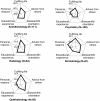Characteristic profiles among students and junior doctors with specific career preferences
- PMID: 24028298
- PMCID: PMC3847686
- DOI: 10.1186/1472-6920-13-125
Characteristic profiles among students and junior doctors with specific career preferences
Abstract
Background: Factors influencing specialty choice have been studied in an attempt to find incentives to enhance the workforce in certain specialties. The notion of "controllable lifestyle (CL) specialties," defined by work hours and income, is gaining in popularity. As a result, many reports advocate providing a 'lifestyle-friendly' work environment to attract medical graduates. However, little has been documented about the priority in choosing specialties across the diverse career opportunities.This nationwide study was conducted in Japan with the aim of identifying factors that influence specialty choice. It looked for characteristic profiles among senior students and junior doctors who were choosing between different specialties.
Methods: We conducted a survey of 4th and 6th (final)-year medical students and foundation year doctors, using a questionnaire enquiring about their specialty preference and to what extent their decision was influenced by a set of given criteria. The results were subjected to a factor analysis. After identifying factors, we analysed a subset of responses from 6th year students and junior doctors who identified a single specialty as their future career, to calculate a z-score (standard score) of each factor and then we plotted the scores on a cobweb chart to visualise characteristic profiles.
Results: Factor analysis yielded 5 factors that influence career preference. Fifteen specialties were sorted into 4 groups based on the factor with the highest z-score: "fulfilling life with job security" (radiology, ophthalmology, anaesthesiology, dermatology and psychiatry), "bioscientific orientation" (internal medicine subspecialties, surgery, obstetrics and gynaecology, emergency medicine, urology, and neurosurgery), and "personal reasons" (paediatrics and orthopaedics). Two other factors were "advice from others" and "educational experience". General medicine / family medicine and otolaryngology were categorized as "intermediate" group because of similar degree of influence from 5 factors.
Conclusion: What is valued in deciding a career varies between specialties. Emphasis on lifestyle issues, albeit important, might dissuade students and junior doctors who are more interested in bioscientific aspects of the specialty or have strong personal reasons to pursue the career choice. In order to secure balanced workforce across the specialties, enrolling students with varied background and beliefs should be considered in the student selection process.
Figures




Similar articles
-
Gender difference in preference of specialty as a career choice among Japanese medical students.BMC Med Educ. 2016 Nov 10;16(1):288. doi: 10.1186/s12909-016-0811-1. BMC Med Educ. 2016. PMID: 27829461 Free PMC article.
-
The variable influence of lifestyle and income on medical students' career specialty choices: data from two U.S. medical schools, 1998-2004.Acad Med. 2005 Sep;80(9):809-14. doi: 10.1097/00001888-200509000-00005. Acad Med. 2005. PMID: 16123458
-
Factors associated with medical students' career choice in different specialties: a multiple cross-sectional questionnaire study at a German medical school.BMC Med Educ. 2024 Jul 24;24(1):798. doi: 10.1186/s12909-024-05751-1. BMC Med Educ. 2024. PMID: 39049024 Free PMC article.
-
Factors Influencing Female Medical Students' Decision to Pursue Surgical Specialties: A Systematic Review.J Surg Educ. 2021 May-Jun;78(3):836-849. doi: 10.1016/j.jsurg.2020.08.050. Epub 2020 Sep 12. J Surg Educ. 2021. PMID: 32933885
-
Career aspirations of specialty among medical students in sub-Saharan Africa: a systematic review and meta-analysis of data from two decades, 2000-2021.BMJ Open. 2022 Aug 26;12(8):e057020. doi: 10.1136/bmjopen-2021-057020. BMJ Open. 2022. PMID: 36028276 Free PMC article.
Cited by
-
Medical Specialty Choice and Related Factors of Brazilian Medical Students and Recent Doctors.PLoS One. 2015 Jul 24;10(7):e0133585. doi: 10.1371/journal.pone.0133585. eCollection 2015. PLoS One. 2015. PMID: 26208007 Free PMC article.
-
Trends in medical students' career choice of emergency medicine: A 14-year study.Turk J Emerg Med. 2020 May 27;20(2):75-80. doi: 10.4103/2452-2473.285017. eCollection 2020 Apr-Jun. Turk J Emerg Med. 2020. PMID: 32587926 Free PMC article.
-
Development and validation of motivators for medical specialist career choice questionnaire (MMSCCQ) - a methodological study.BMC Med Educ. 2022 Jun 20;22(1):474. doi: 10.1186/s12909-022-03523-3. BMC Med Educ. 2022. PMID: 35718765 Free PMC article.
-
The Driving Factors Important for Evaluation Student's Opinion which Influenced Decision Making of Career Choice: Pediatrics as a Career Choice as an Example.Acta Inform Med. 2021 Jun;29(2):94-98. doi: 10.5455/aim.2021.29.94-98. Acta Inform Med. 2021. PMID: 34584330 Free PMC article.
-
Medical Students' Perceptions of Emergency Medicine Careers.Cureus. 2017 Aug 24;9(8):e1608. doi: 10.7759/cureus.1608. Cureus. 2017. PMID: 29075586 Free PMC article.
References
Publication types
MeSH terms
LinkOut - more resources
Full Text Sources
Other Literature Sources
Research Materials

